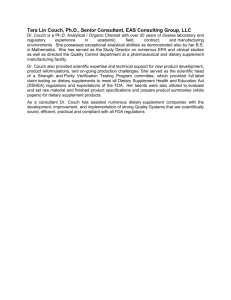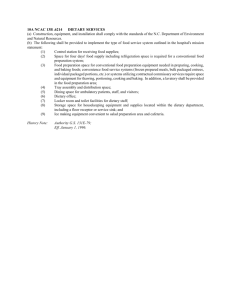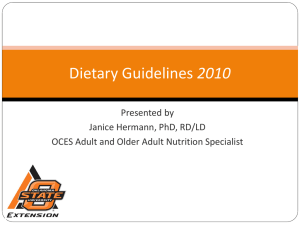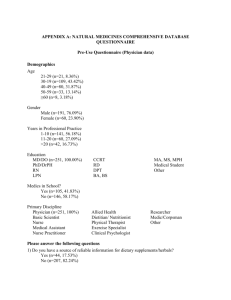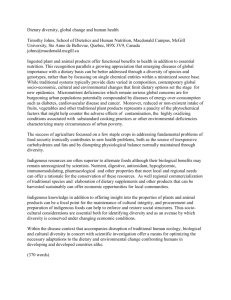Chapter 3: Complementary Nutrition
advertisement
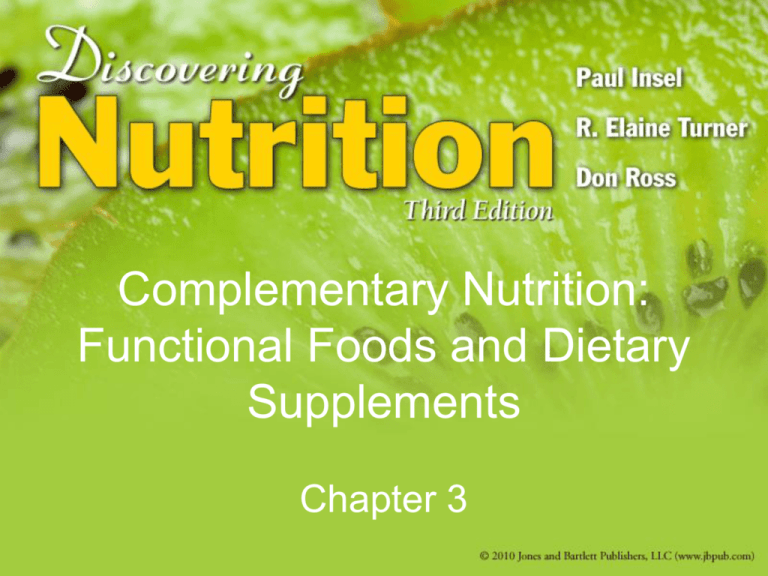
Complementary Nutrition: Functional Foods and Dietary Supplements Chapter 3 Functional Foods • Foods with beneficial physiological or psychological effects beyond providing essential nutrients • May be referred to as medical foods or foods for medical purposes • Contain naturally occurring or added nonnutrients • Foods enhanced with functional ingredients/Regulatory issues Functional Foods • Functional foods are foods that provide health benefits beyond (in addition to) basic nutrition • Many foods may be considered functional foods: – Catechins in black and green tea reduce risk of cancer – Sulforaphane in broccoli reduces cancer risk – Omega-3 fatty acids in fish or flaxseed reduce risk of heart disease & aid joints – Fruits and vegetables contain many different phytochemicals which reduce risk for cancer and heart disease More Functional Foods – Garlic has sulfur compounds that reduce risk for cancer and heart disease – Oats and oat-containing foods, with soluble fiber beta glucan, reduce cholesterol level – Polyphenolic compounds in purple grape juice support normal, healthy cardiovascular function – Soy protein reduces cholesterol levels – Lycopene in tomatoes and products reduce risk for cancer – Yogurt and fermented dairy products contain probiotics which may improve gastrointestinal health Functional Foods • Provide health benefits beyond nutrition • Phytochemicals: – Antioxidants • Neutralize free radicals • Reduce heart disease, cancer risk – Found in fruits, vegetables, whole grains, and legumes, wine Photos © PhotoDisc Free Radicals • Think of them as a kind of acid produced by normal metabolism • Greatly increased by the stress of athletic exertion/exercise • Tear down DNA and cell walls, cause degenerative DZ and cancers • Profoundly linked to “aging” • Neutralized by Antioxidants What do the fruits and veggies do? Provide antioxidants that the body cannot make on its own, thereby blocking free radical damage. What does that damage look like? Skin Wrinkles Joints Arthritis Arteries Heart Disease Brain Alzheimer's DNA Cancer Phytochemicals Make Food Functional • Phytochemicals make food functional – Substances in plants – Promote health – Are not essential for life – Are a benefit to the plant itself © Stephen Coburn/ShutterStock, Inc. Phytochemicals • A phytochemical is a chemical that acts as dietary supplement that comes from plants – Isoflavones from soy – Antioxidants from vegetables – Lycopene from tomatoes Antioxidants aim to: Antioxidants • prevent food containing fat or oil from going rancid due to oxidation, i.e. developing an unpleasant odour or flavour; • prevent the browning of cut fruit, vegetables and fruit juices (and so increase shelf life and appearance). For example, vitamin C, also known as ascorbic acid, or E300, is one of the most widely used antioxidants. Phytochemicals Make Food Functional • Benefits of phytochemicals – Anticancer activity – Prevent chronic disease • Phytoestrogens – Neutralize free radicals Phytochemicals Make Food Functional • Adding phytochemicals to your diet – More fruit – More vegetables – Make half of your grains whole Courtesy of Produce for Better Health Foundation What’s in a clean fresh apple? Over 9,000 phytonutrients in the proper balance for optimal use by our bodies. The colors we need in our lives • Reds – tomatoes, strawberries, watermelon…loaded with Lycopene to protect from prostate cancer Beets contain iron and folic acid. Cranberries have strong antibiotic qualities. • Greens– full of calcium, folic acid, potassium, lutein zeaxanthine, heavy with antioxidants. Kale has 50% more absorbable calcium than milk! Folic acid needed to lower homocysteine, prevent spina bifida and process seretonin which eases depression. The colors we need in our lives • Yellows and oranges – Carrots are an awesome source of beta carotene. Pineapple is a natural anti-inflammatory. • Blues and purples – Grapes with flavinoids decreases the stickiness of our blood. Blackberries reduce colon cancers. Elderberries fight viruses. Blueberries are the highest in antioxidants. Phytochemicals Make Food Functional • Foods enhanced with functional ingredients – Adding health promoting properties during processing Photo © Jones and Bartlett Publishers Phytochemicals Make Food Functional • Regulatory issues – Food – Drugs – Dietary supplements • Additives in functional foods – Herbs and other novel ingredients – GRAS guidelines apply (Generally recognized as safe) Food Additives • Direct additives – Added to foods for specific reason • Indirect additives – Unintentionally become part of a food What is a Food Additive? Sec. 201(s) FFDCA: Definition The term ''food additive'' means any substance the intended use of which results or may reasonably be expected to result, directly or indirectly, in its becoming a component or otherwise affecting the characteristics of any food (including any substance intended for use in producing, manufacturing, packing, processing, preparing, treating, packaging, transporting, or holding food;…. if such substance is not Generally Recognized As Safe, 21 CFR 170.3(e)(1) OFAS’s “Food Ingredients” Universe • Direct Food Ingredients • Sweeteners; Preservatives; Fat; Nutrients; Texturizers (thickeners, Emulsifiers, etc.); Flavors • Color Additives In food, animal feed, drugs, cosmetics,medical devices(i.e. sutures and contact lenses) • GRAS Ingredients Enzymes; Fiber; Proteins; Lipids; Sugars; MSG; Antimicrobials; Phytosterols/stanols; Flavors; Infant formula ingredients • Foods/Ingredients produced using modern biotechnology Plants w/herbicide resistance or insect resistance, delayed ripening, etc.; often use GRAS concept Processing Aids Antimicrobials(meat and poultry Processing); Defoamers; Ion exchange resins • Food Irradiation Equipment To process food To inspect food • Food Packaging/Food Contact Substances Coatings (paper, metal, etc); New/recycled plastics including both polymers and monomers; Paper; Adhesives; Ingredients in Pkgs.(i.e. colorants, antimicrobials, antixoxidants, etc.);Packaging material for use during food irradiation,; Food packaging “formulations” Food Additives • Purpose of direct additives – Maintain product consistency – Improve or maintain nutritional value – Keep food appetizing and wholesome – Provide leavening – Enhance flavor or color Photos © Corbis Digital Images Food Additives • Regulation by FDA – Food additives: FDA approval; manufacturer must prove safety – Color additives: FDA approval; FDA tests batches for purity – Generally Recognized as Safe (GRAS) – Prior sanctioned substance What is a Food Contact Substance? (Section 409(h)(6) of the FFDCA) Any substance intended for use as a component of materials used in manufacturing, packing, packaging, transporting, or holding food if such use is not intended to have any technical effect in food. Unintentional Additives: • Insecticides • Fungicides • Herbicides • Plant Growth Regulators • Hormones and Antibiotics Functions/Purposes: • Prolong shelf life • Change/preserve color • Enhance flavor • Improve nutritional value Functions/Purposes: cont. • Compensate for vitamin and mineral deficiencies • Maintain freshness • Prevent spoiling • Facilitate food processing Food Additives • Subject to Delaney Clause – Apply to food additives – Apply to color additives – No approval if additive causes cancer • Humans • Animals Delaney Clause, 1958 • No substance known to cause cancer in animals or humans at any dose level shall be purposefully added to food. Claims for Functional Foods • Nutrient content claims • Health claims • Structure/function claims – Based on food’s nutrition value Strategies for Functional Food Use • Stick with the science – Eat fruit and vegetables – Eat nutrition-fortified products as needed – Read, read, read (scientific articles) – Be critical of advertising and hype If it sounds too good to be true, it probably is! Dietary Supplements Foods or Drugs? Dietary Supplements • Alternative therapies and natural remedies – (Holistic Medicine) • Dietary supplements = 6.5 billion / Prescription Drug sales = 85 billion • Increased consumer dissatisfaction with conventional health care • ½ of US population use Dietary Supplements History of Dietary Supplements • 1990 Nutritional Labeling and Education Act – Permitted use of therapeutic claims made about vits/mins • 1994 President Clinton signed Dietary Supplement, Health and Education Act (DSHEA) into law • Defined D/S as “separate regulatory category of food” Dietary Supplements • Traditionally defined as products made of one or more essential nutrients such as vitamins, minerals, and proteins, but… • DSHEA broadened definition to include almost any product intended for ingestion as a supplement to the diet • Must be identified on label as a D/S Dietary Supplements: Vitamins and Minerals • Various forms • Moderate doses • Megadoses Dietary Supplements: Vitamins and Minerals • Moderate supplementation – Increased nutrient needs and/or poor intake • Pregnant and breastfeeding women • Women with heavy menstrual losses • Children • Infants Dietary Supplements: Vitamins and Minerals • Moderate supplementation – Increased nutrient needs and/or poor intake • People with severe food restrictions • Strict vegetarians • Elders – No more than 150% of DV Dietary Supplements: Vitamins and Minerals • Megadoses – Conventional medicine • Drug interactions • Malabsorption syndromes • Treatment of deficiencies • Druglike effects – Orthomolecular nutrition • Proposed for disease prevention – Risks: toxicity from large doses Dietary Supplements: Natural Health Products • Herbal therapy (phytotherapy) – Traditional medical practices – Little scientific evidence of efficacy, safety • Helpful herbs: examples – St. John’s wort antidepressant – Milk thistle dyspepsia; diabetes – Ginkgo biloba improve the mind – Saw palmetto extract prostate problems – Cranberry juice Prevents UTI Dietary Supplements: Natural Health Products • Helpful herbs, harmful herbs – Strong enough to help, strong enough to hurt – Can interfere with standard medicines – DANGER: Examples of products with toxic side effects • Yohimbe erectile dysfunction • Ephedra weight loss • Chaparral Wounds; skin probs etc • Comfrey multiple ailments Dietary Supplements: Natural Health Products • Quality control issues – Contaminants – Poorly standardized strength or potency • Regulations – Current good manufacturing practices • Other dietary supplements – Hundreds of products Dietary Supplements in the Marketplace • Freedom of speech and press • The FTC and supplement advertising – Federal Trade Commission • The FDA and supplement regulation – Dietary Supplement Health and Education Act – Dietary supplements are not drugs – Dietary supplements are not food additives – Approval by FDA is not required Dietary Supplements • Distinguished from Drugs: – Drug = article intended to diagnose, cure, mitigate, treat, or prevent disease – Both intended to affect structure and function of body – Drug must undergo FDA approval after clinical studies to determine effectiveness and safety – D/S = no pre-market testing Dietary Supplements in the Marketplace • Supplement labels – Ingredient information – Supplement fact panel Dietary Supplements • Distinguished from Drugs: – Drug = article intended to diagnose, cure, mitigate, treat, or prevent disease – Both intended to affect structure and function of body – Drug must undergo FDA approval after clinical studies to determine effectiveness and safety – D/S = no pre-market testing Dietary Supplements • Distinguished from Foods: – Foods not intended to affect structure and function – D/S intended only to supplement diet • Not represented for use as conventional food • Not intended as sole item of a meal or the diet” Dietary Supplements • No premarket approval • Manufacturer responsible for safety evaluation • If D/S contains a new ingredient: – Manufacturer must submit information that ingredient “can reasonably be expected to be safe” within 75 days of marketing – Safe = no significant risk of illness Labeling of Dietary Supplements • DSHEA authorized to provide accurate information to consumers • Label must include: – Name of each ingredient – Quantity of each ingredient – Total weight of all ingredient if a blend – Identity of part of plant derived from – Term “Dietary Supplement” • Must contain nutritional labeling information also – Calories, fat, sodium Dietary Supplements in the Marketplace Health Claims • DSHEA authorized use of FDA approved “Health claims” on label • Describe the connection between a nutrient or food substance and a disease or health-related condition – (diet/disease relationship) • Statements may be included on the label that give the manufacturers description of the role of the D/S – Not authorized by FDA – Manufacturer resp. for accuracy and truth of statement Dietary Supplements in the Marketplace • Supplement labels – Claims allowed • Health claims (approved by FDA) –Examples • Calcium and osteoporosis • Folate and neural tube defects FDA Approved Health Claims • Folic acid and neural tube pregnancies • Calcium and osteoporosis • Sodium and hypertension • Fruits and vegetables and cancer • Dietary lipids and cancer • Saturated fat and cholesterol and coronary artery disease Structure and Function Claims • Manufacturers may use S/F claims – Not authorized by FDA • Must be true and not misleading • Must be accompanied by disclaimer – “This statement has not been evaluated by the FDA. This product is not intended to diagnose, treat, cure or prevent any disease” • Examples: – “Calcium builds strong bones” – “Antioxidants maintain cell integrity” Dietary Supplements in the Marketplace • Structure/function claims – Link substance and effect on the body – No approval required – Must have “disclaimer” statement on label Other Claims: • Health-maintenance claims: – “Maintains healthy circular system” • Non-disease claims: – “helps you relax” – “for muscle enhancement” • Cannot make maintenance claims about osteoporosis and other “serious diseases” • Can make health claim about relationship between a product or substance and the disease if approved Dietary Supplements in the Marketplace • Nutrient content claims – Consistent with definitions approved for foods • Canadian regulations – Natural health products Dietary Supplements in the Marketplace • Choosing dietary supplements – Is the quantity enough to have an effect? – Is the product new to you? – Consider the dose used in the study – What is its bioavailability? – Does the product promise too much? – Who is selling the product? – U.S. Pharmacopeia verification Dietary Supplements in the Marketplace • Fraudulent products – Secret cure (“breakthrough”) – Pseudomedical jargon (e.g., “detoxify”) – Cures a wide range of diseases – No side effects, only benefits – Backed by “scientific research” you can’t find – Remember, if it sounds too good to be true… Complementary and Alternative Medicine (CAM) • Complementary – Practices used in addition to conventional medicine • Alternative – Practices used in place of conventional medicine Complementary and Alternative Medicine (CAM) • Nutrition in CAM – Vegetarian diets – Macrobiotic diet – Food restrictions and prescriptions – Need for scientific evaluation PREVALENCE OF CAM • • • • General population - 46% at some time Breast cancer patients - 23% $27 billion annually Most common - herbals, megavitamins MAIN POINTS • Balance the rationale and intuition • Tell your doctor what your doing • Don’t forego proven treatments • Find peace with your approach

